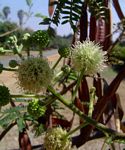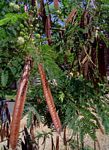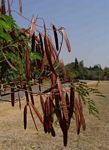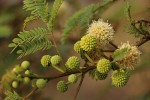| Home | > | List of families | > | Fabaceae subfamily Mimosoideae | > | Leucaena | > | leucocephala |
Leucaena leucocephala
Selected images: Click on each image to see a larger version and details of the record View all images (12)
Detailed records: Display species records QDS maps by: Google Maps Point records by Google Maps
Species details: Click on each item to see an explanation of that item (Note: opens a new window)
| Synonyms: | |
| Common names: | River tamarind (English) |
| Frequency: | Rare |
| Status: | Introduced |
| Description: |
Unarmed shrub or small tree. Branchlets densely covered in grey hairs. Leaves twice compound with a distinct gland on the rhachis between the lowest pair of pinnae. Flowers in spherical heads, white to pale yellow. Pods in clusters, thin and flattened but slightly raised over the seeds, splitting into straight halves. |
| Type location: |
|
| Notes: | Introduced as a fodder tree. It is said to be poisonous to livestock when eaten in large quantities. A rare escape in Zimbabwe but it is a declared weed in parts of South Africa, where it invades roadsides, forest margins and river banks. |
| Derivation of specific name: | leucocephala: with white heads |
| Habitat: | Roadsides and disturbed ground |
| Altitude range: (metres) | |
| Flowering time: | |
| Worldwide distribution: | Native to tropical America |
| National distribution: | C |
| Growth form(s): | Tree, shrub over 2 m. |
| Endemic status: | |
| Red data list status: | |
| Insects associated with this species: | |
| Spot characters: | Display spot characters for this species |
| Images last updated: | Saturday 11 February 2006 |
| Literature: |
Brenan, J.P.M. (1970). Mimosoideae Flora Zambesiaca 3(1) Pages 52 - 53. (Includes a picture). Burrows, J.E., Burrows, S.M., Lötter, M.C. & Schmidt, E. (2018). Trees and Shrubs Mozambique Publishing Print Matters (Pty), Cape Town. Page 233. (Includes a picture). |
Other sources of information about Leucaena leucocephala:
Our websites:
Flora of Burundi: Leucaena leucocephalaFlora of Malawi: Leucaena leucocephala
Flora of Malawi: cultivated Leucaena leucocephala
Flora of Mozambique: Leucaena leucocephala
Flora of Mozambique: cultivated Leucaena leucocephala
Flora of Zambia: cultivated Leucaena leucocephala
Flora of Zimbabwe: cultivated Leucaena leucocephala
External websites:
African Plants: A Photo Guide (Senckenberg): Leucaena leucocephalaAfrican Plant Database: Leucaena leucocephala
BHL (Biodiversity Heritage Library): Leucaena leucocephala
EOL (Encyclopedia of Life): Leucaena leucocephala
GBIF (Global Biodiversity Information Facility): Leucaena leucocephala
Google: Web - Images - Scholar
iNaturalist: Leucaena leucocephala
IPNI (International Plant Names Index): Leucaena leucocephala
JSTOR Plant Science: Leucaena leucocephala
Mansfeld World Database of Agricultural and Horticultural Crops: Leucaena leucocephala
Plants of the World Online: Leucaena leucocephala
Tropicos: Leucaena leucocephala
Wikipedia: Leucaena leucocephala
| Home | > | List of families | > | Fabaceae subfamily Mimosoideae | > | Leucaena | > | leucocephala |




